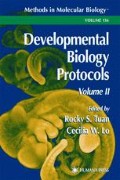Abstract
The identification of novel, developmentally regulated genes whose products play roles in the differentiation of specific vertebrate tissues and organs can be accomplished using a method called gene trapping (1-9). This technique involves inserting a marker gene, such as β-galactosidase or alkaline phosphatase, into the genome of murine embryonic stem (ES) cells using one of several available methods of transfection. The gene trap construct contains an antibiotic resistance gene such as neomycin to permit the selection of transfected clones. ES cell clones are picked and expanded on multiwell plates before freezing. Screening of the clones for tissue-specific gene expression involves thawing multiwell dishes, expanding them, and allowing them to differentiate in vitro into multiple cell lineages (10-14).
Access this chapter
Tax calculation will be finalised at checkout
Purchases are for personal use only
References
Baker, R. K., Haendel, M. A., Swanson, B. J., Shambaugh, J. C., Micales, B. K., and Lyons, G. E. (1997) In vitro preselection of gene-trapped embryonic stem cell clones for characterizing novel developmentally regulated genes in the mouse. Dev. Biol. 185, 201–214.
Friedrich, G. and Soriano, P. (1991) Promoter traps in embryonic stem cells: a genetic screen to identify and mutate developmental genes in mice. Genes Dev. 5, 1513–1523.
Scherer, C. A., Chen, J., Nachabeh, A., Hopkins, N., and Ruley, H. E. (1996) Transcriptional specificity of the pluripotent embryonic stem cell. Cell Growth Diff. 7, 1393–1401.
Gossler, A. and Zachgo, J. (1993) Gene and enhancer trap screens in ES cell chimeras, in Gene Targeting: A Practical Approach (Joyner, A., ed.), IRL, Oxford, pp. 181–225.
Hill, D. P. and Wurst, W. (1993) Gene and enhancer trapping: mutagenic strategies for developmental studies. Curr. Topics Dev. Biol. 28, 181–206.
Joyner, A. L. (1991) Gene targeting and gene trap screens using embryonic stem cells: new approaches to mammalian development. Bioassays 13, 649–656.
Skarnes, W. C., Auerbach, B. A., and Joyner, A. L. (1992) A gene trap approach in mouse embryonic stem cell: the lacZ reporter gene is activated by splicing, reflects endogenous gene expression, and is mutagenic in mice. Genes Dev. 6, 903–918.
Takeuchi, T., Yamazaki, Y., Katoh-Fukui, Y., Tsuchiya, R., Kondo, S., Motoyama, J., and Higashinakagawa, T. (1995) Gene trap capture of a novel mouse gene, jumonji, required for neural tube formation. Genes Dev. 9, 1211–1222.
Wurst, W., Rossant, J., Prideaux, V., Kownacka, M., Joyner, A., Hill, D. P., Guillemot, F., Gasca, S., Cado, D., Auerbach, A., and Ang, S.-L. (1995) A large-scale gene-trap screen for insertional mutations in developmentally regulated genes in mice. Genetics 139, 889–899.
Doetschman, T. C., Eistetter, H., Katz, M., Schmidt, W., and Kemler, R. (1985) The in vitro development of blastocyst-derived embryonic stem cells lines: formation of visceral yolk sac, blood islands and myocardium. J. Embryol. Exp. Morphol. 87, 27–45.
Keller, G. M. (1995) In vitro differentiation of embryonic stem cells. Curr. Opin. Cell Biol. 7, 862–869.
Baker, R. K. and Lyons, G. E. (1996) Embryonic stem cells and in vitro muscle development. Curr. Topics Dev. Biol. 33, 263–279.
Strübing, C., Ahnert-Hilger, G., Shan, J., Wiedenmann, B., Hescheler, J., and Wobus, A. M. (1995) Differentiation of plutipotent embryonic stem cells into the neuronal lineage in vitro gives rise to mature inhibitory and excitatory neurons. Mech. Dev. 53, 275–287.
Wang, R., Clark, R., and Bautch, V. L. (1992) Embryonic stem cell-derived cystic embryoid bodies form vascular channels: an in vitro model of blood vessel development. Development 114, 303–316.
Williams, R. L., Hilton, D. J., Pease, S., Willson, T., Stewart, C., Gearing, D., Wagner, E., Metcalf, N., and Gough, N. M. (1988) Myeloid leukemia inhibitory factor maintains the developmental potential of embryonic stem cells. Nature 336, 684–687.
Soriano, P., Friedrich, G., and Lawinger, P. (1991) Promoter interactions in retrovirus vectors introduced into fibroblasts and embryonic stem cells. J. Virol. 6, 2314–2319.
Robertson, E. J. (1987) Embryo-derived stem cell lines, in Teratocarcinomas and Embryonic Stem Cells: A Practical Approach (Robertson, E. J., ed.), IRL, Oxford, pp. 71–112.
Pederson, R. A. (1994) Studies of in vitro differentiation with embryonic stem cells. Reprod. Fertil. Dev. 6, 543–552.
Bain, G., Kitchens, D., Yao, M., Huettner, J. E., and Gottlieb, D. I. (1995) Embryonic stem cells express neuronal properties in vitro. Dev. Biol. 168, 342–357.
Wiles, M. V. (1993) Embryonic stem cell differentiation in vitro, in Guide to Techniques in Mouse Development, Methods in Enzymology, vol. 225, Academic, New York, pp. 900–918.
Wobus, A. M., Rohwedel, J., Maltsev, V., and Hescheler, J. (1994) In vitro differentiation of embryonic stem cells into cardiomyocytes or skeletal muscle cells is specifically modulated by retinoic acid. Roux’s Arch. Dev. Biol. 204, 36–45.
Forrester, L. M., Nagy, A., Sam, M., Watt, A., Stevenson, L., Bernstein, A., Joyner, A., and Wurst, W. (1996) An induction gene trap screen in embryonic stem cells: identification of genes that respond to retinoic acid in vitro. Proc. Natl. Acad. Sci. USA 93, 1677–1682.
Chen, Z. (1996) Simple modifications to increase specificity of the 5’ RACE procedure. Trends Genet. 12, 8788.
Author information
Authors and Affiliations
Editor information
Editors and Affiliations
Rights and permissions
Copyright information
© 2000 Humana Press Inc.
About this protocol
Cite this protocol
Lyons, G.E., Swanson, B.J., Haendel, M.A., Daniels, J. (2000). Gene Trapping in Embryonic Stem Cells In Vitro to Identify Novel Developmentally Regulated Genes in the Mouse. In: Tuan, R.S., Lo, C.W. (eds) Developmental Biology Protocols: Volume II. Methods in Molecular Biology™, vol 136. Humana Press. https://doi.org/10.1385/1-59259-065-9:297
Download citation
DOI: https://doi.org/10.1385/1-59259-065-9:297
Publisher Name: Humana Press
Print ISBN: 978-0-89603-853-0
Online ISBN: 978-1-59259-065-0
eBook Packages: Springer Protocols

